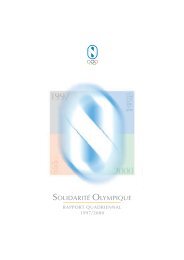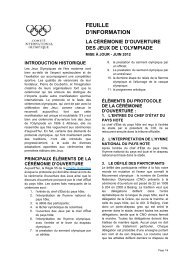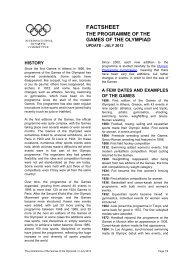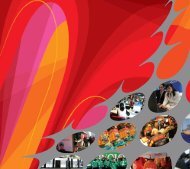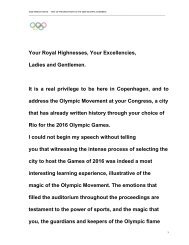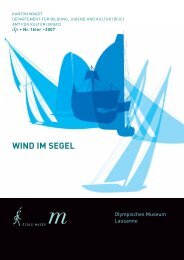London 2012 Olympic Summer Games Injury & Illness Surveillance ...
London 2012 Olympic Summer Games Injury & Illness Surveillance ...
London 2012 Olympic Summer Games Injury & Illness Surveillance ...
Create successful ePaper yourself
Turn your PDF publications into a flip-book with our unique Google optimized e-Paper software.
<strong>London</strong> <strong>2012</strong><br />
<strong>Olympic</strong> <strong>Summer</strong> <strong>Games</strong><br />
<strong>Injury</strong> & <strong>Illness</strong><br />
<strong>Surveillance</strong> Study<br />
Detailed information for NOC medical staff
© International <strong>Olympic</strong> Committee <strong>2012</strong>
Table of contents<br />
Foreword 3<br />
Introduction 4<br />
Confidentiality 4<br />
Methods 5<br />
1. What should be reported? 5<br />
2. Who reports? 6<br />
3. When to report? 6<br />
4. What details should be reported? 7<br />
5. How to return the report forms? 7<br />
Appendix 1 : Examples of how to record acute injuries 8<br />
Examples of how to record acute illness 10<br />
Appendix 2 : “Daily report on Injuries and <strong>Illness</strong>es” form 12 - 13<br />
Research team 14
Foreword<br />
Dear Colleagues,<br />
It is with great pleasure that we welcome you to <strong>London</strong> for the <strong>2012</strong> <strong>Summer</strong> <strong>Olympic</strong> <strong>Games</strong>. We are pleased to provide<br />
you with this introductory booklet, which will explain to you the details of the IOC <strong>Injury</strong> & <strong>Illness</strong> <strong>Surveillance</strong> Study.<br />
As you may know, the IOC is increasingly emphasizing work on the protection of the athletes’ health and prevention of<br />
injuries and illnesses.<br />
During the 2004 <strong>Olympic</strong> <strong>Games</strong>, injuries in all team sport tournaments (football, handball, basketball, field hockey,<br />
baseball, softball, water polo and volleyball) were surveyed, and the IOC extended the project to all sports events during<br />
the 2008 <strong>Olympic</strong> <strong>Games</strong> in Beijing. Further improvements were made in the 2010 Winter <strong>Olympic</strong> <strong>Games</strong> in Vancouver,<br />
where also illnesses were recorded. The surveillance study provide the sports world with invaluable data that help<br />
us identify injury and illness risk factors and mechanisms, that, in turn, is used to develop and implement prevention<br />
measures and thus create safer sports for the athletes’ benefit.<br />
You, as the team physicians and physiotherapists, are crucial to the success of the project, and we kindly ask you to<br />
report all injuries and illnesses of your athletes on a daily basis on the provided report forms and return them to<br />
the IOC research team. All information will be treated with the strictest confidentiality.<br />
This booklet provides comprehensive information on how to fill in and return the daily report form. The IOC research<br />
group will process the data, and you will receive a formal report of the study in due course after the end of the <strong>Olympic</strong><br />
<strong>Games</strong>. Our goal is to transfer the science into practice to provide you with valuable information that will enable you to<br />
organise your work in a more efficient way to prevent sports injuries among your athletes.<br />
Thank you very much for your valuable contribution!<br />
Prof. Arne Ljungqvist Dr Patrick Schamasch Prof. Lars Engebretsen<br />
Medical Commission Chairman Medical and Scientific Director Head of Scientific Activities<br />
3
Introduction<br />
<strong>Injury</strong> surveillance provides not only important epidemiological information, but also direction for injury prevention. During<br />
the 2004 <strong>Olympic</strong> <strong>Games</strong>, the eight international team sports federations (FIBA, FIFA, FINA, the FIH, the FIVB, IBAF, the<br />
IHF and the ISF) participated in a study on the frequency and characteristics of injuries in all 14 team sport tournaments<br />
using an established injury-surveillance system. The acceptance and compliance of the project was excellent, as<br />
demonstrated by the response rate exceeding 90% for almost all tournaments. The findings, which were consistent with<br />
previous studies, demonstrated the high quality of the data obtained.<br />
In Beijing 2008 the injury surveillance system was slightly modified to be applicable for both individual and team<br />
sports, and in Vancouver 2010 to also monitor illnesses. Thanks to the collaboration with you, the NOC physicians<br />
and physiotherapists, the quality of the data reported in these <strong>Games</strong> was excellent. The results from the IOC injury<br />
surveillance system have been published in the renowned peer-reviewed journals British Journal of Sports Medicine and<br />
American Journal of Sports Medicine.<br />
The aims of the present study are to record newly acquired illnesses and sports injuries incurred in competitions and/or<br />
training during the <strong>2012</strong> <strong>Summer</strong> <strong>Olympic</strong> <strong>Games</strong> in <strong>London</strong>.<br />
Confidentiality<br />
The accreditation number of the athletes will be used only to avoid double reports from team and LOCOG physicians<br />
and to obtain information on age, gender, nationality and national federation of the athlete from the IOC database. The<br />
accreditation number of the athletes will not be entered into the injury and illness database; all injury & illness<br />
report forms will be stored in a locked filing cabinet and will be made anonymous after the <strong>2012</strong> <strong>London</strong> <strong>Olympic</strong> <strong>Games</strong>.<br />
All reporting will be either for groups of athletes, or in a way that no individual athlete or team can be identified.<br />
Confidentiality of all information will be ensured.<br />
4
Methods<br />
This injury and illness-reporting system can be briefly summarised as follows:<br />
During the <strong>2012</strong> <strong>Summer</strong> <strong>Olympic</strong> <strong>Games</strong>, the NOC physicians or physiotherapists of all participating teams are requested<br />
to report all injuries newly incurred in competitions and/or training and all illnesses (or the non-occurrence of injuries/<br />
illnesses) daily using a specially designed, single-page report form. <strong>Injury</strong> and illness data will also be obtained from the<br />
medical staff of the local organizing committee. The report form is available in eight languages (English, French, Arabic,<br />
Chinese, German, Japanese, Russian and Spanish) on paper form and electronically. All information will be treated as<br />
strictly confidential. The team physicians will receive a formal report of the study in due course after the <strong>Olympic</strong> <strong>Games</strong>.<br />
1<br />
What should be reported?<br />
All newly acquired injuries of athletes<br />
An injury is defined as any musculoskeletal complaint and/or concussion newly incurred due to competition and/or training<br />
during the <strong>2012</strong> <strong>Summer</strong> <strong>Olympic</strong> <strong>Games</strong> in <strong>London</strong> that received medical attention regardless of the consequences<br />
with respect to absence from competition and/or training.<br />
This injury definition includes four aspects:<br />
1. all injuries that received medical attention (not only time-loss injuries);<br />
2. newly incurred (pre-existing, not fully rehabilitated injuries should not be reported);<br />
re-injuries (injuries of the same location and type) should be reported only if the athlete<br />
has returned to full participation after the previous injury;<br />
3. in-competition or training injuries;<br />
4. during the period of the <strong>Olympic</strong> <strong>Games</strong> (27 July to 12 August <strong>2012</strong>).<br />
All newly acquired illnesses of athletes<br />
An illness is defined as any physical complaint (not related to injury) newly incurred during the <strong>2012</strong> <strong>Summer</strong> <strong>Olympic</strong><br />
<strong>Games</strong> that received medical attention regardless of the consequences with respect to absence from competition and/<br />
or training.<br />
This illness definition includes three aspects:<br />
1. all illness that received medical attention (not only those resulting in time-loss);<br />
2. newly incurred (pre-existing and chronic illnesses should not be reported except the athlete suffers an acute<br />
exacerbation);<br />
3. during the period of the <strong>Olympic</strong> <strong>Games</strong> (27 July to 12 August <strong>2012</strong>).<br />
5
2<br />
6<br />
Who reports?<br />
National <strong>Olympic</strong> Committee medical staff (team<br />
physician, physiotherapist, etc., i.e. qualified medical staff)<br />
Injuries and illnesses should be diagnosed and reported by qualified medical personnel (team physician,<br />
physiotherapist, etc.) to ensure valid information on the characteristics of the injury and/or illness and a comparable<br />
standard of the data. It is advantageous if each team designates one contact person who will take part in the Team<br />
Physicians’ meeting and will be accessible for questions during the period of the <strong>Olympic</strong> <strong>Games</strong>.<br />
In order to receive information about injured/ill athletes of teams without a physician or medical personnel, injuries and<br />
illnesses will also be reported by the medical personnel of LOCOG.<br />
3<br />
When to report?<br />
On a daily basis<br />
Acute injury and illness should be reported daily. The IOC injury & illness surveillance system requires a daily<br />
report regardless of whether or not any injury has occurred. This procedure is important to distinguish between the<br />
non-occurrence of injuries and illnesses from a missing report of a team.
4<br />
What details should be reported?<br />
Newly acquired injury<br />
The injury component of the report form requires documentation of the following information: accreditation number of the<br />
athlete, sport and event, round / heat / training, date and time of injury, injured body part, type and cause of injury and<br />
an estimate of the expected duration of subsequent absence from competition and/or training.<br />
athlete’s accreditation no.<br />
1234569587979<br />
injured body part, side<br />
wrist, le�<br />
code<br />
15<br />
sport and event<br />
athl�ics – 100m (women)<br />
type of injury<br />
sprain<br />
code<br />
8<br />
round, heat or training<br />
quarter �nal – 1st heat<br />
cause of injury<br />
sli�ed and fell<br />
Definitions and codes are given on the back page of the report form (see appendix 2, page 13).<br />
code<br />
21<br />
date and time of injury<br />
7.08.<strong>2012</strong>, 14:35<br />
absence in days<br />
10<br />
In the situation when the diagnosis (or the duration of absence) is revised later as more information about the injury<br />
becomes available, the team physician should report the injury again (with the previous data and location of injury to<br />
indicate that this is a revised report) and state the corrected information. You will find more examples on how to fill in the<br />
injury report form in appendix 2.<br />
Newly acquired illness<br />
The illness component of the report form requires documentation of the following information: accreditation number of<br />
the athlete, sport and event, diagnosis, date of first occurrence, affected system, main symptom(s), cause of illness and<br />
an estimate of the expected duration of subsequent absence from competition and/or training.<br />
athlete’s accreditation no.<br />
1564579587979<br />
affected system<br />
uro-genital<br />
code<br />
3<br />
sport and event<br />
football (men)<br />
main symptom(s)<br />
pain<br />
code<br />
2<br />
diagnosis<br />
cystitis<br />
cause of illness<br />
infection<br />
Definitions and codes are given on the back page of the report form (see appendix 2, page 13).<br />
5<br />
How to return the report forms?<br />
code<br />
2<br />
occurred on (date)<br />
2.08.<strong>2012</strong><br />
absence in days<br />
0<br />
The completed report forms should be submitted to the injury and illness study researchers at the IOC Medical<br />
Commission office in the <strong>Olympic</strong> Village polyclinic, or sent by email to torbjorn.soligard@olympic.org.<br />
7
Appendix 1 :<br />
Examples of how to record acute injuries<br />
1. A female hammer-thrower developed shoulder instability during training and sought medical attention; the condition<br />
did not prevent the athlete from taking full part in training or competition even though it caused the player some pain.<br />
The team physiotherapist recommended an individual training programme for the athlete to avoid aggravating the<br />
condition.<br />
8<br />
athlete’s accreditation no.<br />
1234569587979<br />
injured body part, side<br />
shoulder, le�<br />
code<br />
11<br />
sport and event<br />
hammer throw (women)<br />
type of injury<br />
instability<br />
code<br />
5<br />
round, heat or training<br />
training<br />
cause of injury<br />
overuse (gradual ons�)<br />
code<br />
1<br />
date and time of injury<br />
10.08.<strong>2012</strong>, 08:00<br />
absence in days<br />
0<br />
2. A decathlete sustained an ankle sprain during competition but continued to compete; the athlete received medical<br />
attention following the competition. The athlete completed full competition using ankle taping (with some pain) but<br />
aggravated the injury the following day; the athlete then required rehabilitation and stopping from training. Estimated<br />
duration of treatment = 15 days.<br />
athlete’s accreditation no.<br />
1234569587979<br />
injured body part, side<br />
ankle, right, medial<br />
code<br />
27<br />
sport and event<br />
decathlon (women)<br />
– high jump<br />
type of injury<br />
sprain<br />
code<br />
8<br />
Second Incident should be recorded as another injury<br />
athlete’s accreditation no.<br />
1234569587979<br />
injured body part, side<br />
ankle, right, medial<br />
code<br />
27<br />
sport and event<br />
decathlon – 1500 m<br />
type of injury<br />
sprain<br />
code<br />
8<br />
round, heat or training<br />
comp�ition – �rst day<br />
cause of injury<br />
non contact trauma<br />
round, heat or training<br />
comp�ition – second day<br />
cause of injury<br />
recurrence of injury<br />
code<br />
3<br />
code<br />
4<br />
date and time of injury<br />
7.08.<strong>2012</strong>, 17:00<br />
absence in days<br />
0<br />
date and time of injury<br />
8.08.<strong>2012</strong>, 12:00<br />
absence in days<br />
15<br />
3. Male football player is hit in the head by arm of another player. He suffers from a contusion to his cheek, a laceration<br />
to his eyelid and a concussion.<br />
athlete’s accreditation no.<br />
1234569587979<br />
injured body part, side<br />
head<br />
code<br />
1, 2<br />
sport and event<br />
football (men)<br />
type of injury<br />
concussion,<br />
laceration, contusion<br />
code<br />
1, 11,<br />
16<br />
round, heat or training<br />
comp�ition – preliminary round<br />
cause of injury<br />
contact with other player<br />
code<br />
11<br />
date and time of injury<br />
29.07.<strong>2012</strong>, 12:00<br />
absence in days<br />
7
4. A beach volley player sprained her left ankle during training. She received treatment by the PT, and was then taken<br />
to the hospital for MRI and secondary treatment.<br />
athlete’s accreditation no.<br />
1234569587979<br />
injured body part, side<br />
ankle, le�, lateral<br />
code<br />
27<br />
sport and event<br />
beach volleyball (women)<br />
type of injury<br />
sprain<br />
code<br />
8<br />
round, heat or training<br />
training<br />
cause of injury<br />
non contact trauma<br />
Revised diagnosis (after MRI) should also be provided on the injury report form.<br />
athlete’s accreditation no.<br />
1234569587979<br />
injured body part, side<br />
ankle, le�, lateral<br />
code<br />
27<br />
sport and event<br />
beach volleyball (women)<br />
type of injury<br />
ligament rupture<br />
without instability<br />
code<br />
7<br />
round, heat or training<br />
training<br />
cause of injury<br />
already reported<br />
5. A football player sustained a rotation injury to his right knee during the first game of the <strong>Games</strong>.<br />
athlete’s accreditation no.<br />
TAM 1234569587979<br />
injured body part, side<br />
knee, right, medial<br />
code<br />
24<br />
sport and event<br />
football (men)<br />
type of injury<br />
sprain<br />
code<br />
8<br />
round, heat or training<br />
match against Germany<br />
cause of injury<br />
contact with other player<br />
code<br />
3<br />
date and time of injury<br />
30.07.<strong>2012</strong>, 10:45<br />
absence in days<br />
2<br />
date and time of injury<br />
30.07.<strong>2012</strong>, 10:45<br />
code absence in days<br />
>20<br />
code<br />
11<br />
date and time of injury<br />
04.08.<strong>2012</strong>, 18:42<br />
absence in days<br />
>14<br />
6. A marathon runner suffers a muscular cramp in the gastrocnemius and has to quit the race. Expected to not miss<br />
time.<br />
athlete’s accreditation no.<br />
1234569587979<br />
injured body part, side<br />
gastrocnemius<br />
code<br />
25<br />
sport and event<br />
marathon<br />
type of injury<br />
cramps<br />
code<br />
19<br />
round, heat or training<br />
comp�ition<br />
cause of injury<br />
overuse (sudden ons�)<br />
code<br />
2<br />
date and time of injury<br />
9.08.<strong>2012</strong>, 11:35<br />
absence in days<br />
0<br />
7. A male 10000m runner slipped on wet ground and sustained a laceration to the leg during a morning training<br />
session; the physician sutured the cut but the athlete missed the afternoon training session. The athlete was able to<br />
take a full part in competition on the following day.<br />
athlete’s accreditation no.<br />
1234569587979<br />
injured body part, side<br />
calf, le�<br />
code<br />
25<br />
sport and event<br />
10000m (men)<br />
type of injury<br />
cut<br />
code<br />
16<br />
round, heat or training<br />
training – morning session<br />
cause of injury<br />
sli�ed on w� ground<br />
8. A table tennis player fell down and sprained his ankle when getting off the bus on his way to the venue.<br />
Incident should not be recorded as an injury.<br />
code<br />
3<br />
date and time of injury<br />
11.08.<strong>2012</strong>, 10:00<br />
absence in days<br />
0<br />
9
Examples of how to record acute illness<br />
1. A female basketball player develops sudden onset of fever and a sore throat for 2 days. On examination, she is found<br />
to have acute tonsillitis. She is expected to miss 2 days of training and competition.<br />
10<br />
athlete’s accreditation no.<br />
1234569587979<br />
affected system<br />
respiratory<br />
code<br />
1<br />
sport and event<br />
bask�ball (women)<br />
– preliminary<br />
main symptom(s)<br />
fever, pain<br />
code<br />
1, 2<br />
diagnosis<br />
tonsillitis, cold<br />
cause of illness<br />
infection<br />
code<br />
2<br />
occurred on (date)<br />
30.07.<strong>2012</strong>,<br />
12:15<br />
absence in days<br />
2<br />
2. A female weightlifter suddenly becomes ill after dinner with abdominal cramping, vomiting and diarrhea. A diagnosis<br />
of acute gastroenteritis was made. She is expected to miss 3 days of training.<br />
athlete’s accreditation no.<br />
1234569587979<br />
affected system<br />
gastrointestinal<br />
code<br />
2<br />
sport and event<br />
weightli�ing (women, 53kg)<br />
main symptom(s)<br />
abdominal cramping,<br />
vomiting, diarrhoea<br />
code<br />
2, 3<br />
diagnosis<br />
gastroenteritis<br />
cause of illness<br />
dinner<br />
code<br />
4<br />
occurred on (date)<br />
3.08.<strong>2012</strong>,<br />
19:00<br />
absence in days<br />
3<br />
3. A male 5000m runner with known stable asthma suddenly becomes acutely short of breath upon arrival in the<br />
competition venue. He complains of cough and shortness of breath. He requires medical intervention for stabilization.<br />
He is expected to miss 1 day of competition.<br />
athlete’s accreditation no.<br />
1234569587979<br />
affected system<br />
respiratory<br />
code<br />
1<br />
sport and event<br />
5000m (men)<br />
– semi-�nal<br />
main symptom(s)<br />
cough and shortness<br />
of breath<br />
code<br />
4<br />
diagnosis<br />
asthma<br />
cause of illness<br />
asthma, environmental<br />
code<br />
1, 4<br />
occurred on (date)<br />
5.08.<strong>2012</strong>,<br />
10:45<br />
absence in days<br />
1
4. A female race walker collapses at the finish line after the 20k race. She complains of dizziness, weakness and<br />
confusion. She requires medical intervention for stabilization. She is not expected to miss time from competition as<br />
her event is complete.<br />
athlete’s accreditation no.<br />
1234569587979<br />
affected system<br />
cardiovascular<br />
code<br />
4<br />
sport and event<br />
racewalking – 20k (women)<br />
main symptom(s)<br />
dizziness, weakness<br />
and confusion<br />
code<br />
8,<br />
11<br />
diagnosis<br />
dehydration<br />
cause of illness<br />
exercise induced<br />
code<br />
3<br />
occurred on (date)<br />
9.08.<strong>2012</strong>,<br />
13:00<br />
absence in days<br />
0<br />
5. A female hockey player with known diabetes presents to the medical clinic for a renewal of her insulin prescription.<br />
Her sugars are stable and she does not require any medical intervention.<br />
This illness should not be reported.<br />
11
Appendix 2 :<br />
Report REPORT-INJURIES-ILLNESSES_LONDON_EN_Mise form for acute injuries en page 1 16.05.12 & illnesses<br />
08:02 Page1<br />
12<br />
NOC Report by (name) Date of report /<strong>2012</strong><br />
Contact details (e-mail/tel.)<br />
Please report: (1) All injuries (traumatic and overuse) and (2) all illnesses newly incurred in competition or training during the <strong>Olympic</strong> <strong>Games</strong> regardless of the consequences<br />
with respect to absence from competition or training. The information provided is for medical and research purposes and will be treated confidentially.<br />
1. <strong>Injury</strong> – Example<br />
athlete’s accreditation no.<br />
123456789<br />
injured body part, side<br />
wrist, le�<br />
4<br />
code<br />
15<br />
sport and event<br />
athl�ics, 100m (women)<br />
type of injury<br />
sprain<br />
5<br />
code<br />
8<br />
round, heat or training<br />
quarter �nal / 1st heat<br />
cause of injury<br />
sli�ed and fell<br />
code<br />
21<br />
date and time of injury<br />
7.8.<strong>2012</strong> - 14:35<br />
absence in days<br />
10<br />
athlete’s accreditation no. sport and event round, heat or training date and time of injury<br />
injured body part code type of injury code cause of injury code absence in days<br />
athlete’s accreditation no. sport and event round, heat or training date and time of injury<br />
injured body part code type of injury code cause of injury code absence in days<br />
athlete’s accreditation no. sport and event round, heat or training date and time of injury<br />
injured body part code type of injury code cause of injury code absence in days<br />
2. <strong>Illness</strong> – Example<br />
athlete’s accreditation no.<br />
1564579587979<br />
affected system<br />
r�piratory<br />
7<br />
code<br />
1<br />
Daily Report on<br />
Injuries and <strong>Illness</strong>es<br />
athlete’s accreditation no. sport and event round, heat or training date and time of injury<br />
injured body part code type of injury code cause of injury code absence in days<br />
sport and event<br />
fo�ball (men)<br />
main symptom(s)<br />
fever,pain<br />
8<br />
code<br />
1, 2<br />
diagnosis<br />
tonsillitis, cold<br />
cause of illness<br />
infe�ion<br />
6<br />
code<br />
2<br />
occurred on (date)<br />
02.08.<strong>2012</strong><br />
absence in days<br />
2<br />
athlete’s accreditation no. sport and event diagnosis occurred on (date)<br />
affected system code main symptom(s) code cause of illness code absence in days<br />
athlete’s accreditation no. sport and event diagnosis occurred on (date)<br />
affected system code main symptom(s) code cause of illness code absence in days<br />
No injury or illness in any athlete of our team today<br />
2<br />
2<br />
Please use additional forms if needed.<br />
Definitions and codes of 1 to 6 see reverse<br />
Definitions and codes of 1 2 7 8 and 9 see reverse<br />
9<br />
3<br />
1<br />
1<br />
© F-MARC 2009<br />
Front page
REPORT-INJURIES-ILLNESSES_LONDON_EN_Mise en page 1 16.05.12 08:02 Page2<br />
1<br />
2<br />
3<br />
4<br />
5<br />
6<br />
7<br />
8<br />
9<br />
Back page<br />
Codes and classifications<br />
Estimated duration of absence from training or competition (in days)<br />
Please provide an estimate of the number of days that the athlete will not be able to undertake his/her normal training programme or<br />
will not be able to compete.<br />
0 = 0 days<br />
1 = 1 day<br />
2 = 2 days<br />
7 = 1 week<br />
14 = 2 weeks<br />
21 = 3 weeks<br />
28 = 4 weeks<br />
> 30 = more than 4 weeks<br />
> 180 = 6 months or more<br />
Sport and event<br />
Please state the event. For example: swimming – 4x100m freestyle relay (women); track – 110m hurdles (men); taekwondo – under<br />
58kg (men); cycling – team sprint (women)<br />
For Injuries<br />
Round, heat or training<br />
If the injury occurred during competition, please state the round (e.g. heats, qualification B, final).<br />
If the injury occurred on another occasion, please specify whether it was training, warm-up or other.<br />
Injured body part (location of injury)<br />
Head and trunk<br />
1 face (incl. eye, ear, nose)<br />
2 head<br />
3 neck / cervical spine<br />
4 thoracic spine / upper back<br />
5 sternum / ribs<br />
6 lumbar spine / lower back<br />
7 abdomen<br />
8 pelvis / sacrum / buttock<br />
Type of injury (diagnosis)<br />
1 concussion (regardless of loss of consciousness)<br />
2 fracture (traumatic)<br />
3 stress fracture (overuse)<br />
4 other bone injuries<br />
5 dislocation, subluxation<br />
6 tendon rupture<br />
7 ligamentous rupture<br />
Cause of injury<br />
1 overuse (gradual onset)<br />
2 overuse (sudden onset)<br />
3 non-contact trauma<br />
4 recurrence of previous injury<br />
For <strong>Illness</strong>es<br />
Affected system<br />
1 respiratory / ear, nose, throat<br />
2 gastro-intestinal<br />
3 uro-genital / gynaecological<br />
4 cardio-vascular<br />
Main symptom(s)<br />
1 fever<br />
2 pain<br />
3 diarrhoea, vomiting<br />
4 dyspnoea, cough<br />
Cause of illness / symptom(s)<br />
1 pre-existing (e.g. asthma, allergy)<br />
2 infection<br />
Upper extremity<br />
11 shoulder / clavicle<br />
12 upper arm<br />
13 elbow<br />
14 forearm<br />
15 wrist<br />
16 hand<br />
17 finger<br />
18 thumb<br />
8 sprain (injury of joint and /or ligaments)<br />
9 lesion of meniscus or cartilage<br />
10 strain / muscle rupture / tear<br />
11 contusion / haematoma / bruise<br />
12 tendinosis / tendinopathy<br />
13 arthritis / synovitis / bursitis<br />
14 fasciitis / aponeurosis injury<br />
11 contact with another athlete<br />
12 contact: moving object (e.g. puck)<br />
13 contact: stagnant object (e.g. pole)<br />
14 violation of rules (obstruction, pushing)<br />
5 allergic / immunological<br />
6 metabolic / endocrinological<br />
7 haematological<br />
8 neurological / psychiatric<br />
5 palpitations<br />
6 hyper-thermia<br />
7 hypo-thermia<br />
8 dehydration<br />
3 exercise-induced<br />
4 environmental<br />
Lower extremity<br />
21 hip<br />
22 groin<br />
23 thigh (a: anterior / p: posterior)<br />
24 knee (m: medial / l: lateral)<br />
25 lower leg (a: anterior / p: posterior)<br />
26 Achilles tendon<br />
27 ankle (m: medial / l: lateral)<br />
28 foot / toe<br />
15 impingement<br />
16 laceration / abrasion / skin lesion<br />
17 dental injury / broken tooth<br />
18 nerve injury / spinal cord injury<br />
19 muscle cramps or spasm<br />
20 other<br />
21 field of play conditions<br />
22 weather condition<br />
23 equipment failure<br />
24 other<br />
9 dermatologic<br />
10 musculo-skeletal<br />
11 dental<br />
12 other<br />
9 syncope, collapse<br />
10 anaphylaxis<br />
11 lethargy, dizziness<br />
12 other<br />
5 reaction to medication<br />
6 other<br />
© F-MARC 2009<br />
13
Research team<br />
Prof. Lars Engebretsen (Norway) IOC lars.engebretsen@medisin.uio.no<br />
Dr Torbjørn Soligard (Norway) IOC torbjorn.soligard@nih.no<br />
Dr Kathrin Steffen (Norway) IOC kathrin.steffen@nih.no<br />
Prof. Per Renström (Sweden) IOC per.renstrom@telia.com<br />
Dr Juan Manuel Alonso (Espagne) IAAF dir.medico@rfea.es<br />
Dr Mark Aubry (Canada) IIHF markaubry@rogers.com<br />
Prof. Jiri Dvorak (Switzerland) FIFA jiri.dvorak@kws.ch<br />
Prof. Willem Meeuwisse (Canada) University of Calgary w.meeuwisse@ucalgary.ca<br />
Dr Margo Mountjoy (Canada) FINA mmsportdoc@aol.com<br />
Dr Debbie Palmer-Green (United Kingdom) LOCOG debbie.palmer@eis2win.co.uk<br />
Dr Ivor Vanhegan (United Kingdom) LOCOG ivanhegan@nhs.net<br />
If in doubt, please do not hesitate to contact any of the above.<br />
14<br />
Thank you very much indeed<br />
for your valuable contribution!







